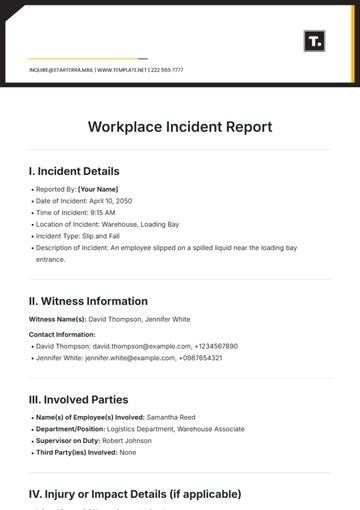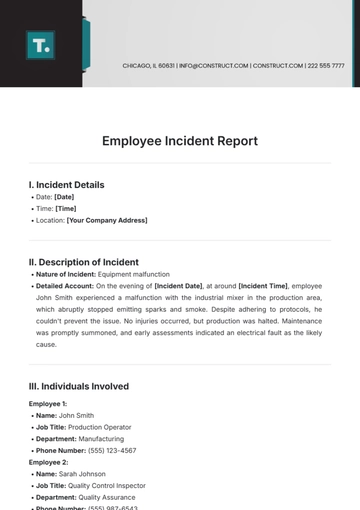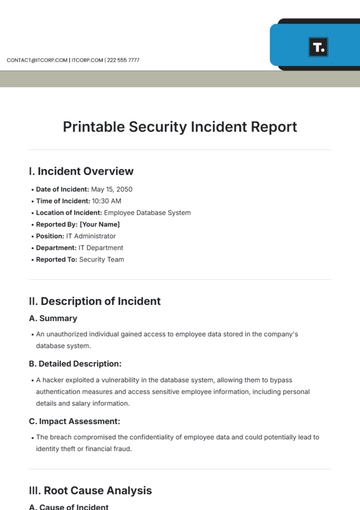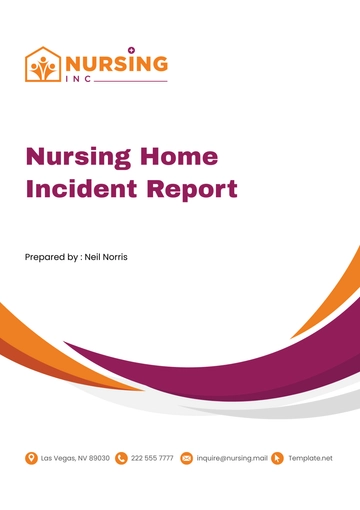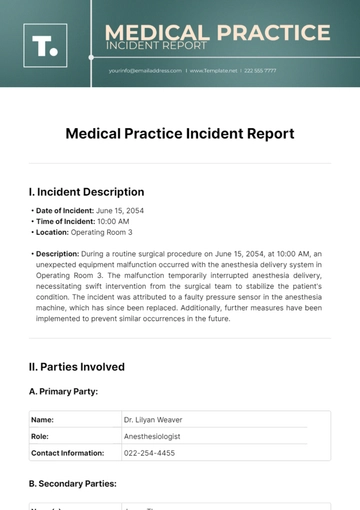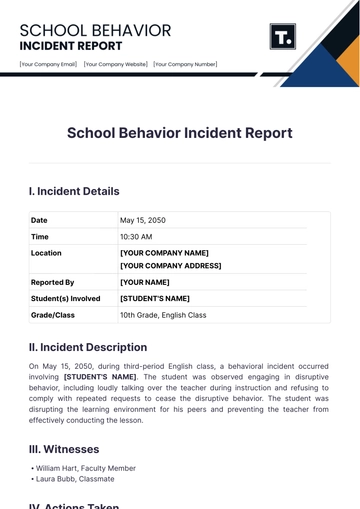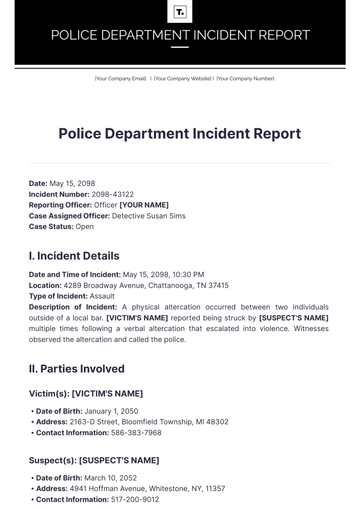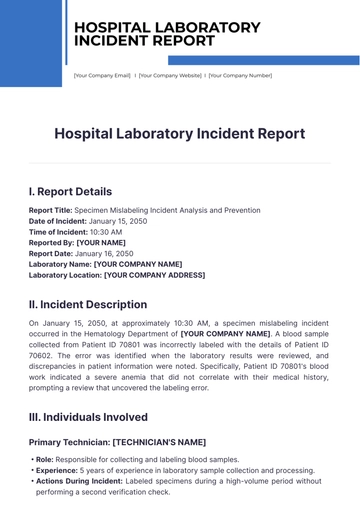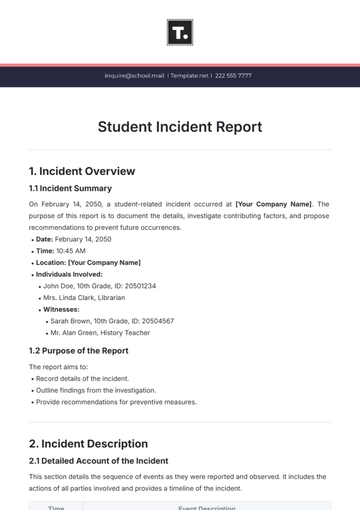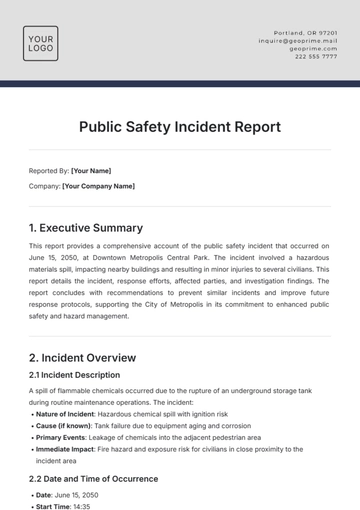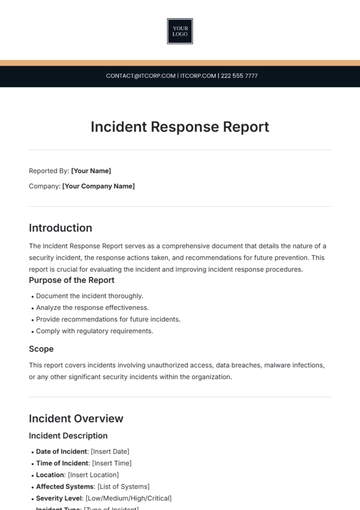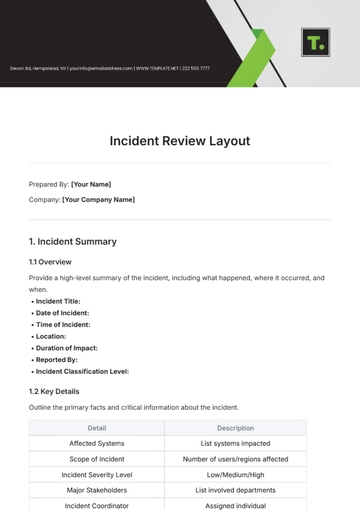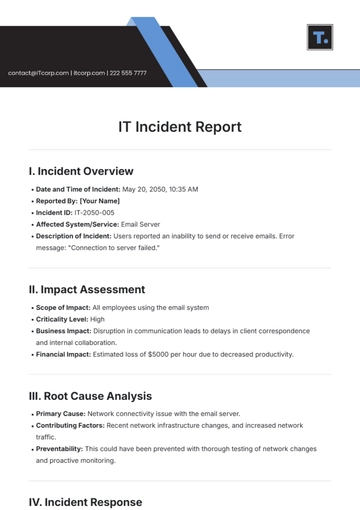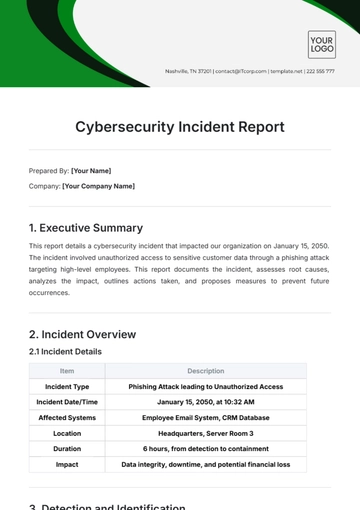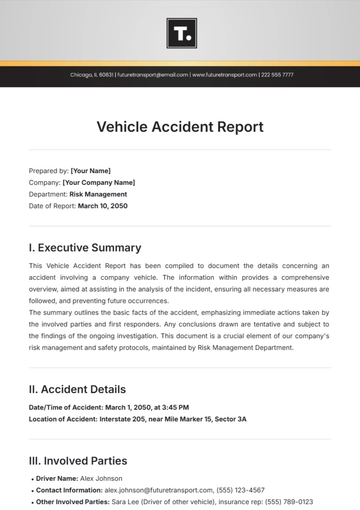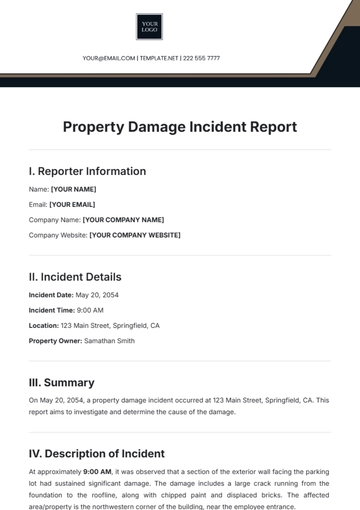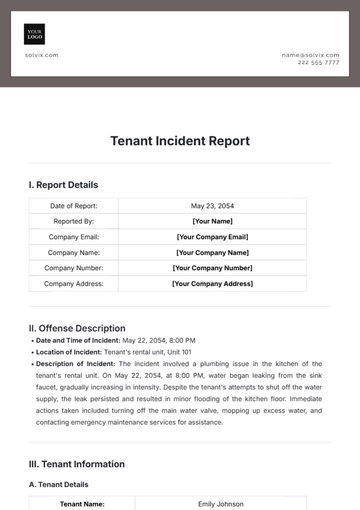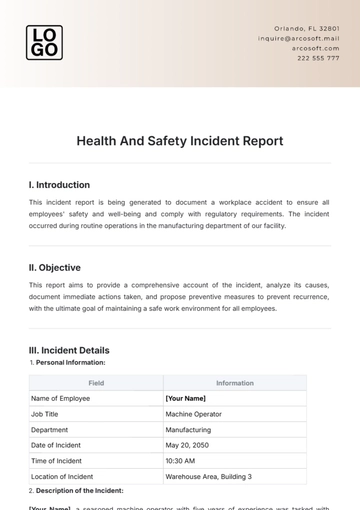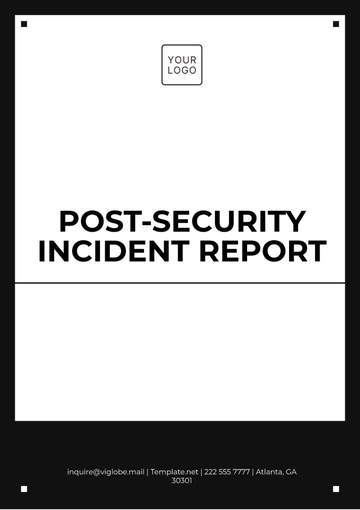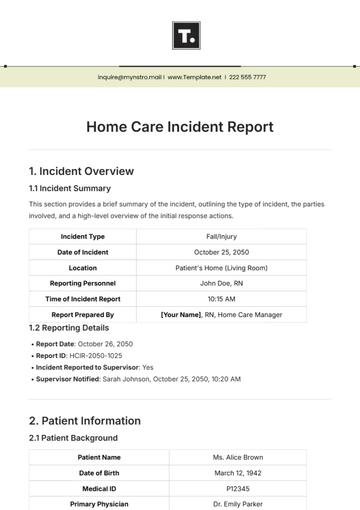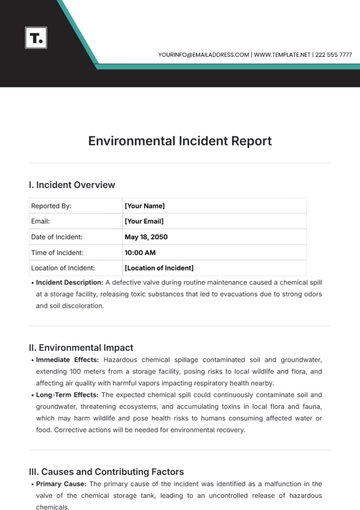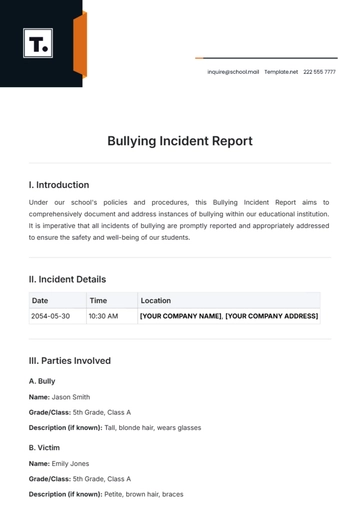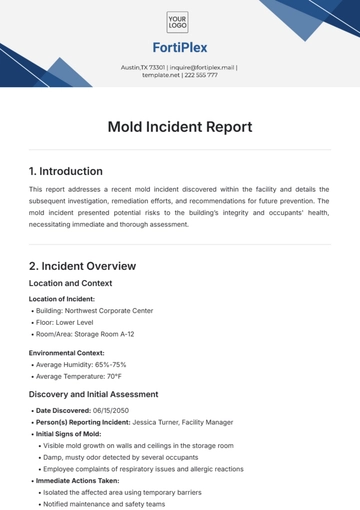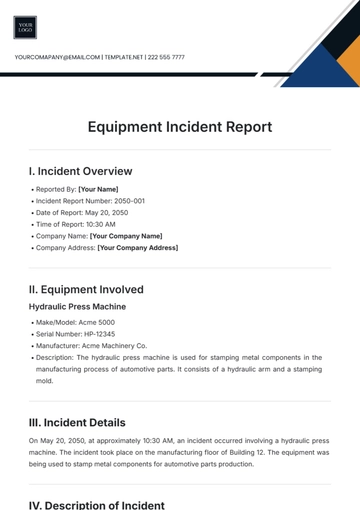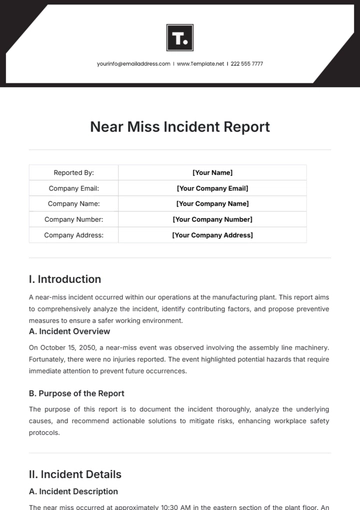Free Professional Incident Narrative Report

I. Incident Overview
This section provides a comprehensive summary of the incident, outlining the key elements and scope. The overview serves as an introduction to the specifics that are covered in the subsequent sections, providing a concise snapshot of the incident's nature and implications.
1. Date and Time of Incident
The incident took place on October 12, 2053, at approximately 3:45 PM. At this time, an unexpected event occurred that resulted in significant operational disruptions.
2. Location
The incident occurred at the main production facility, located at [YOUR COMPANY NAME]. The specific area affected was the central manufacturing unit.
3. Parties Involved
The incident involved multiple stakeholders, including:
[YOUR NAME], Supervisor
Isabelle Harris, Operator
Chloe Emard, Maintenance Technician
Ellis Bednar, Safety Officer
II. Incident Description
This section details the circumstances and causes of the incident, providing a factual account of what transpired before, during, and after the event. It includes a detailed analysis aimed at identifying contributing factors.
1. Initial Conditions
The production line was operating under normal conditions before the incident. All machinery had been routinely checked, and no anomalies were reported in the logs prior to the disruption.
2. Sequence of Events
At exactly 3:45 PM, an automated alert was triggered indicating a critical failure in Unit 3 of the production line. The subsequent series of events is outlined below:
3:46 PM - Operator Jane Smith acknowledged the alert and initiated standard emergency protocols.
3:50 PM - Maintenance Technician Tim Lee arrived at the scene to assess the situation.
3:55 PM - Safety Officer Mary Johnson declared a temporary evacuation of the affected area.
4:10 PM - A full power shutdown was executed to prevent further damage.
3. Potential Causes
Based upon the initial investigation, the following potential causes have been identified:
Mechanical failure due to wear and tear
Overload of manufacturing unit leading to overheating
Software malfunction in the automated control system
III. Incident Impact
This section evaluates the impact of the incident on operations, personnel safety, and other critical factors. Understanding the full extent of the incident's repercussions helps in planning mitigation strategies.
1. Operational Impact
The incident caused a halt in production, resulting in the following operational impacts:
Impact Type | Description |
|---|---|
Production Downtime | Approximately 6 hours of halted production affecting schedule commitments. |
Resource Allocation | Reallocation of technical resources to resolve the issue and implement immediate fixes. |
Financial Loss | An estimated loss of $50,000 due to stopped production and repairs. |
2. Safety Impact
Thankfully, no injuries were reported. However, safety protocols were effectively tested, revealing opportunities for enhancing evacuation efficiency in future drills.
3. Stakeholder Impact
The incident necessitated communication with stakeholders, including:
Investors - Ensuring continued confidence in operational management.
Clients - Discussed potential delays with pending orders.
Employees - Additional training workshops announced post-incident review.
IV. Mitigation and Recommendations
This section focuses on strategies to prevent similar incidents in the future, outlining actionable recommendations and improvements based on the insights gained from the incident review.
1. Immediate Actions Implemented
Immediate repair and replacement of faulty components on the production line.
Enhanced inspections and maintenance procedures initiated.
2. Long-term Recommendations
Upgrade existing machinery with advanced diagnostic tools for predictive maintenance.
Regular training for staff to improve response times and efficiency during emergencies.
Develop a comprehensive business continuity plan that includes alternative operational strategies during outages.
V. Conclusion
The incident highlighted key areas for improvement in operational resilience and safety protocols. By addressing these issues, the organization can reinforce its commitment to excellence and safety, ensuring that such incidents are minimized in the future.
- 100% Customizable, free editor
- Access 1 Million+ Templates, photo’s & graphics
- Download or share as a template
- Click and replace photos, graphics, text, backgrounds
- Resize, crop, AI write & more
- Access advanced editor
Streamline your reporting with the Professional Incident Narrative Report Template from Template.net. This editable and customizable template simplifies incident documentation, ensuring clarity and accuracy. Powered by our AI Editable Tool, you can easily tailor each report to your needs, enhancing efficiency and professionalism. Perfect for businesses looking to maintain detailed records effortlessly.
You may also like
- Sales Report
- Daily Report
- Project Report
- Business Report
- Weekly Report
- Incident Report
- Annual Report
- Report Layout
- Report Design
- Progress Report
- Marketing Report
- Company Report
- Monthly Report
- Audit Report
- Status Report
- School Report
- Reports Hr
- Management Report
- Project Status Report
- Handover Report
- Health And Safety Report
- Restaurant Report
- Construction Report
- Research Report
- Evaluation Report
- Investigation Report
- Employee Report
- Advertising Report
- Weekly Status Report
- Project Management Report
- Finance Report
- Service Report
- Technical Report
- Meeting Report
- Quarterly Report
- Inspection Report
- Medical Report
- Test Report
- Summary Report
- Inventory Report
- Valuation Report
- Operations Report
- Payroll Report
- Training Report
- Job Report
- Case Report
- Performance Report
- Board Report
- Internal Audit Report
- Student Report
- Monthly Management Report
- Small Business Report
- Accident Report
- Call Center Report
- Activity Report
- IT and Software Report
- Internship Report
- Visit Report
- Product Report
- Book Report
- Property Report
- Recruitment Report
- University Report
- Event Report
- SEO Report
- Conference Report
- Narrative Report
- Nursing Home Report
- Preschool Report
- Call Report
- Customer Report
- Employee Incident Report
- Accomplishment Report
- Social Media Report
- Work From Home Report
- Security Report
- Damage Report
- Quality Report
- Internal Report
- Nurse Report
- Real Estate Report
- Hotel Report
- Equipment Report
- Credit Report
- Field Report
- Non Profit Report
- Maintenance Report
- News Report
- Survey Report
- Executive Report
- Law Firm Report
- Advertising Agency Report
- Interior Design Report
- Travel Agency Report
- Stock Report
- Salon Report
- Bug Report
- Workplace Report
- Action Report
- Investor Report
- Cleaning Services Report
- Consulting Report
- Freelancer Report
- Site Visit Report
- Trip Report
- Classroom Observation Report
- Vehicle Report
- Final Report
- Software Report
